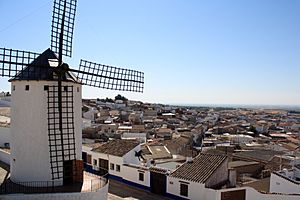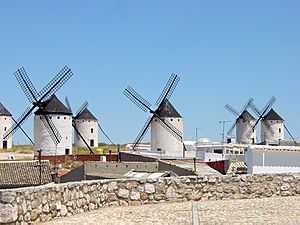Campo de Criptana facts for kids
Quick facts for kids
Campo de Criptana
|
|||
|---|---|---|---|

Campo de Criptana
|
|||
|
|||
| Country | |||
| Autonomous community | Castilla–La Mancha | ||
| Province | Ciudad Real | ||
| Comarca | Mancha Alta | ||
| Judicial district | Alcázar de San Juan | ||
| Commonwealth | Promancha | ||
| Area | |||
| • Total | 302.41 km2 (116.76 sq mi) | ||
| Elevation | 707 m (2,320 ft) | ||
| Highest elevation | 780 m (2,560 ft) | ||
| Lowest elevation | 635 m (2,083 ft) | ||
| Population
(2018)
|
|||
| • Total | 13,597 | ||
| • Density | 44.9621/km2 (116.451/sq mi) | ||
| Demonym(s) | criptanense | ||
| Time zone | UTC+1 (CET) | ||
| • Summer (DST) | UTC+2 (CEST) | ||
| Postal code |
13610
|
||
Campo de Criptana is a town and municipality in the province of Ciudad Real in Castilla–La Mancha, Spain. It is located in the region known as La Mancha. This area is famous for its windmills, which were featured in the classic book Don Quixote.
Contents
Explore Campo de Criptana's Past
Ancient Roots and Early Settlements
People have lived in the area around Campo de Criptana since prehistoric times. Tools for hunting, gathering, and farming have been found here. There are also many ancient pots, especially from the Bronze Age. Later, during Roman times, people from the Iberian culture also lived here.
The town of Campo de Criptana as we know it today started in the 13th century. However, other settlements existed nearby much earlier. Some important old towns included Criptana, Villajos, Posadas Viejas, and El Campo.
How Campo de Criptana Grew
The original settlement called Criptana was given to the Order of St. John in 1162. It was meant to be resettled. Later, it became part of the Order of Santiago. But by the 14th century, this old Criptana was no longer inhabited.
Villajos, another ancient settlement, was also mentioned in 1162. It was home to people since prehistoric times. It also became empty by the 12th century. Today, a small church (hermitage) stands where its original church once was.
Not much is known about Posadas Viejas, but it was also abandoned around 1300.
The town of El Campo grew in the current location of Campo de Criptana. It was built around a fortified spot on a hill called Cerro de la Paz. This spot was like a guard post for the old Criptana Castle. Even though it was newer, many people moved here from the other settlements. They might have liked the good water and air. These older towns eventually disappeared, and their people joined the new community. This new town was first called Campo de Criptana in the early 14th century.
Growth and Economy Through the Centuries
Throughout the Middle Ages, Campo de Criptana grew. The leaders of the Order of Santiago helped the town develop. By 1575, there were about 1,000 households (around 4,000-5,000 people). This number grew even more by the early 1600s.
However, times were tough for rural communities. Bad weather, diseases, poor harvests, and high taxes caused the population to drop. It took a long time for the town to recover, well into the 19th century.
At first, the local economy relied on farming grains, olives, and grapes. Wool production was also important. In the 1800s, industries like flour milling and wine-making started. The arrival of the railway in the late 1800s helped these industries grow even more. In the second half of the 20th century, tourism became a new and important part of the local economy.
Until 1999, the nearby town of Arenales de San Gregorio was part of Campo de Criptana. It then became its own independent municipality.
How the Town Center Developed
The town center began in the 13th century around the fortified Cerro de La Paz. The hills and plains shaped how the town grew.
In the 16th century, Campo de Criptana became very successful. Many new buildings were constructed. These included public buildings like the Granary and religious ones like churches and convents. But a national crisis in the 17th century stopped the town's growth for a while.
After the Peninsular War (1808–1814), the town recovered. It became an important farming center with a growing population. Wealthy families built new homes in the city center. This changed the town from mostly farmland to a place with more houses and businesses.
When the railway arrived in the late 1800s, new factories were built near the train station. This led to more growth in the southeastern part of town.
The town continued to expand southwards into flatter areas during the early 1900s. The population reached its highest point in 1950 with over 15,000 people. However, many people then moved to bigger cities, causing the population to decrease.
In the last 25 years of the 20th century, the town grew rapidly again. New homes and businesses were built. This growth was sometimes unplanned, but the town has been working to improve its infrastructure since 1981.
Must-See Monuments and Places
Famous Windmills
"At this point they caught sight of thirty or forty windmills which were standing on the plain..." This famous line from Don Quixote describes the windmills of Campo de Criptana. In the time of Miguel de Cervantes, windmills were very common. The sight of these windmills is a symbol of Campo de Criptana.
In the 1800s, there were 34 windmills here. We know from old remains that there were once even more.
Today, ten windmills still stand. They have their original structure and machinery. Visitors can go inside some of them to learn how they worked. Other windmills have been turned into museums. For example, the Inca Garcilaso is about farming, and the Pilón is about wine. The Poyatos windmill is home to the local tourism office. Every Saturday, one of the restored windmills is put into operation.
In 1978, all the windmills were declared a Monument of Historical-Artistic Interest. This means they are now a protected Cultural Heritage Site.
The Pósito (Old Granary)
A pósito is a special building used to store grain, especially wheat. It was run by the local government. Its main purpose was to help farmers during difficult times by providing them with grain. It also helped control the price of wheat and bread.
The granary in Campo de Criptana dates back to the 16th century. It was later updated and made bigger by King Charles III. The main entrance has a beautiful arch and three coats of arms above it. Two of these coats of arms belong to the Order of Santiago.
The granary was used until the Peninsular War (1808–1814). After that, it was no longer needed. In 1914, it was sold to private owners. But in 1991, the local government bought it back. They restored it to be a town museum where exhibitions and cultural events can be held. The restoration work was so good that it received an award in 1997.
Church of Nuestra Señora de la Asunción
This is a modern church that opened in 1958. It was built on the same spot where an older 16th-century church stood. The original church was destroyed by fire in 1936 during the Spanish Civil War.
Convent Church
This church belonged to the convent of the Barefoot Carmelites. It was taken over by the government in the 19th century. Its current look comes from changes made in the 18th century. It has a dome with a lantern on top. Inside, there is a special shrine to the Thousand and One Virgins, which was given to the church in 1612.
Hermitage of the Virgen de la Paz
This small church is located near the Cerro de la Paz hill, offering amazing views of the countryside. For many centuries, it was dedicated to St. Christopher, who was believed to protect people from plagues. It is surrounded by small white houses that look similar to the hermitage. It has a rectangular shape with a single main room and a vaulted ceiling.
Besides this one, there are nine more hermitages around Criptana:
- Hermitage of Veracruz
- Hermitage of Santa Ana
- Hermitage of la Madre de Dios
- Hermitage of San Cristóbal
- Hermitage of the Concepción
- Hermitage de San Sebastián
- Hermitage de San Pedro
- Hermitage of Cristo de Villajos
- Hermitage of the Virgen de Criptana
Unique Streets and Neighbourhoods
The streets that go around the Cerro de la Paz hill follow the shape of the old town. They are on a hillside, which makes Campo de Criptana different from other towns in La Mancha, which are usually on flat land.
In the late 16th century, many families from Granada moved to the eastern part of the town. This new area became known as the Albaicín. It was named after an old neighborhood in Granada. The houses there still have their traditional Arabic tiles, painted in white and indigo, and beautiful iron grilles on the windows.
Local Festivals
Campo de Criptana celebrates several traditional festivals throughout the year:
- Festival of the Santísima Virgen de Criptana (held on Easter Monday)
- Festival of Santísimo Cristo de Villajos (held on the first Thursday in August)
- Carnival
- Holy Week
Delicious Local Food

When you visit Campo de Criptana, you can try these typical dishes:
- gachas manchegas: A savory dish often made with flour, pork, garlic, and paprika.
- migas de pastor: Fried bread crumbs mixed with ham, garlic, and paprika.
- cordero a la caldereta: A tasty lamb stew.
- pisto manchego: A dish similar to ratatouille, made with vegetables like tomatoes, peppers, and zucchini.
- Garlic soup
- Scrambled eggs with onion and manchego cheese
- arroz con duz frío: A cold rice dessert with caramel.
See also
 In Spanish: Campo de Criptana para niños
In Spanish: Campo de Criptana para niños







